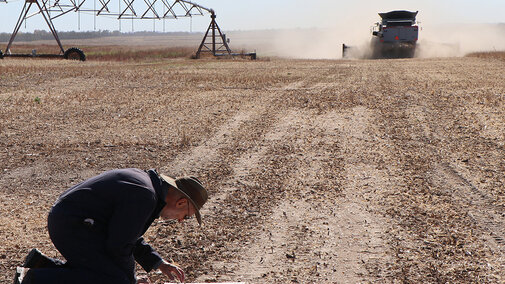The dry edible bean harvest in Box Butte County wrapped up last month. Some direct harvest beans were the last to leave the fields on Oct. 20, including Nebraska farmer Tim Hashman’s plot outside of Alliance. Hashman is working with Nebraska Extension Educator John Thomas on a Nebraska On-Farm Research Network project dealing with direct harvest and a product called Pod Ceal.
“Pod Ceal is new to me, so we’re trying it with the university,” Hashman said. “To my understanding, it toughens up the pod and makes it harder to shatter by the wind and everything else.”
The trial is in its second year. While the first year didn’t have any significant results, Thomas is interested to see the results this year and if there are any differences.
“We had some light hail in late summer on some of the acres,” he said. “The beans with Pod Ceal appeared to have slightly less bean loss when I checked them after the storm. So we’ll have to see after harvest how the beans compare in yield, harvest loss and quality.”
The research plot is about 50 acres of an upright bean variety called Gleam. Harvesting upright beans is different than when beans are windrowed. In the later, the whole bean plant is cut, and it lies on the ground in windrows before another pass by the combine harvests the beans. Direct harvest completes the entire process in one pass, but an issue can be bean harvest loss.
“The Pod Ceal product is supposed to help keep the pods from shattering in the field before and during harvest,” Thomas said.
To get an idea of how Pod Ceal performed, Thomas and colleague Gary Stone, Nebraska Extension educator, joined Hashman for the harvest. Thomas rode in the combine, and Stone walked behind the combine, counting the beans on the ground considered harvest loss. Stone used the UNL “Frame Estimator,” copyrighted in 1995, as a management tool for estimating harvest loss. He randomly dropped the frame on the ground and counted the beans inside the square to get a sample of bean loss. Thomas also gathered samples from the combine bin.
“I gather a half-gallon of beans so we can get a quality analysis from the bean elevator. They look at splits, cracks, foreign matter and percent moisture,” Thomas said.
The on-farm research project replicates the study four times in the field, with and without the Pod Ceal product. Replicating the applications across the field helps remove variability caused by factors such as soil differences, weather, and variable disease or insect pressure.
Hashman and his family have grown upright bean varieties for more than 10 years.
“We really like the harvest system and the upright varieties that they have been coming out with,” he said. “This year the Gleam (variety) has been doing very well for us.”
Hashman’s dry bean plot is only one of 80-plus studies going on across Nebraska. To find out more about the other studies, visit the Nebraska On-Farm Research Network site.
The annual On-Farm Research Update meeting in Alliance will be on Wednesday, Feb. 21, 2024, with information on this year’s project results and others in the Panhandle.
Additional locations for the 2023 On-Farm Research Update meetings will be announced in the following weeks. See CropWatch or the Nebraska On-Farm Research Network for more information.

